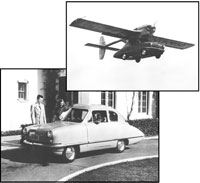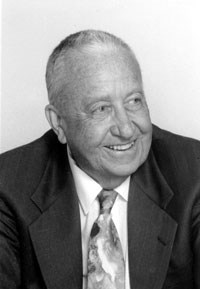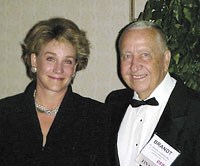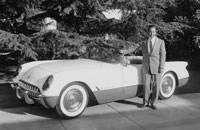Brandt Goldsworthy: Composites Visionary
A tribute to a pioneer and innovator who helped define seven decades of composites industry history.
W. Brandt Goldsworthy, an honored pioneer in the plastics and composites industries, passed away on April 3, 2003, in Torrance, Calif., U.S.A. He was born on May 21, 1915.
A native Californian, he completed his education in Mechanical Engineering at the University of California, Berkeley in 1935. Over a nearly 70 year career, Goldsworthy worked in every facet of the composites industry. He designed products and machinery to make cutting-edge products used from undersea to outer space. He founded and sold numerous companies, and was awarded over 50 patents.
According to his extensive curriculum vitae, his lifelong interest in reinforced plastics began while at his first job with the Douglas Aircraft Co. in El Segundo, Calif. During World War II he served as a plastics engineer in the company's Process Engineering Group. Between 1942 and 1944, he pioneered the use of cast phenolic resin combined with fiberglass to produce some of the first fiberglass-reinforced laminated tools in the industry. Molded glass/phenolic ammunition chutes were one of his developments while at Douglas, a system that was adopted by every aircraft company during the war. The post-formed laminated chutes supported the machine gun cartridges as they fed out of their storage boxes and into the sides of aircraft machine guns.
In 1945, Goldsworthy founded Industrial Plastics Corp., the first reinforced plastics fabrication plant on the U.S. West Coast. The plant produced reinforced plastic tools and structures for military equipment and aircraft, made from fiberglass and newly available polyester resins. Never satisfied with hand molding processes, Goldsworthy researched and developed automated equipment for producing fiberglass preforms and chopped fiber mat. He did early work in the use of matched metal dies for closed molding with chopped fiber reinforcement forms and improved the surface finish of fiberglass molded parts. He developed a programmable, continuously variable roving cutter for use in conjunction with automated preform equipment, as well. Industrial Plastics was the leader in developing composite automobile, boat and aircraft parts, based on the preforming process.
During this time, Goldsworthy first worked on the pultrusion process, incorporating an innovative radio-frequency pre-cure chamber, initially conceived to make small-diameter reinforced plastic bar stock for fishing rods. He later founded Glastrusions Inc. — the world's first pultrusion plant — and further developed the Glastruder pultrusion system, which was later sold to Morrison Molded Fiber Glass (MMFG), now known as Strongwell, in 1974.
Also during this period, Goldsworthy — an avid surfer and member of the original San Onofre Surf Club — joined Pete Peterson to develop the original fiberglass surfboard.
In 1947, he was approached by the Consolidated Vultee Aircraft Co., to design and engineer a combined automobile and airplane. Goldsworthy ultimately produced the prototypes at his facility. The vaunted Convair flying car prototype flew successfully on several occasions, but was ultimately destroyed in a California mudslide.
The post-war car-building boom led Henry Kaiser to establish a reinforced plastics research laboratory, with Goldsworthy as its consulting director, in Emeryville, Calif., U.S.A. That association led to the development of fiberglass bodies for Kaiser's Darrin automobile. A few years later, General Motors decided on a fiberglass body for its new Corvette sports car. Goldsworthy was asked to consult on the program's design, tooling and production phases. Between 1951 and 1953 he commuted between California and Ashtabula, Ohio, U.S.A., where the first Corvette body panels were hand layed up in open molds by Molded Fiber Glass Co.
In 1956, he decided to become a full-time consultant, and sold Industrial Plastics Corp. to H.I. Thompson Fiberglass Co., now known as HITCO Carbon Composites (Gardena, Calif.). As a consultant, he worked in virtually every phase of composites development, both in the U.S. and abroad. In the military area, he spent a great deal of time developing ablative materials and fabricating techniques, applied to re-entry cones, rocket motor liners, blast tubes and nozzles. He holds patents involving an innovative ablative mat material. He also continued to develop filament winding technology, and holds patents on a new type of filament winder that produces square and rectangular parts.
In 1966, he founded Goldsworthy Engineering Inc. in partnership with Ferro Corp. (Plymouth, Ind., U.S.A.) to design and build automated equipment for processing composites, with employees Tiny Hardesty, Denny Franks, Bill Johnson and Donna Dawson. A notable project was his development for Owens Corning (Toledo, Ohio, U.S.A.) of a winding machine for winding glass roving packages without twist. Goldworthy, always an advocate of automated manufacturing processes, designed and built a prodigious number of new machines, including tape placement machines, CNC filament winding machines, continuous pipe-making machinery and on-site tank manufacturing equipment. He also developed pultrusion capabilities for a wide range of profiles and complex shapes, including curved pultrusion/pulforming, and he engineered automated composite material cutting and kitting equipment for airframe components.
Dawson recounts that during pultrusion development efforts, Goldsworthy and his team wanted to investigate how long a continuous part could be made, so they started pultruding a 0.25-inch rod one afternoon. The rod eventually reached out the plant door, around the building, back in the front office door, up the stairs and down the hallway. When she arrived at work the next morning, Dawson found a short section of the 0.25-inch rod and an empty champagne bottle on her desk. Glastrusions established licenses in every major industrial country in the world and helped develop pultrusion into the internationally recognized process it is today. Goldsworthy served as president of Glastrusions until its acquisition by MMFG.
An early big job for Goldsworthy Engineering was an order from Thiokol for a numerical tape-controlled filament winder at Redstone Arsenal — remotely controlled because it was designed to wind rocket motor cases directly over solid propellant. The machine was still operational a few years ago, according to Dawson.
In 1965, Goldsworthy and Hardesty were asked to create a plan to convey potable water 26 miles from the California mainland at San Pedro to Catalina Island. Although the project was never completed, their solution was to pultrude continuous composite pipe on a ship and lay it down on the ocean floor as the ship moved. Another innovation, also never realized, was a concept for the Trans-Canada oil pipeline, using the pipeline itself as the supply line and to house and protect the personnel from the environment. He consulted with NASA and the Space Studies Institute located at Princeton University in the development of a plan for mining on the moon and for making fibers from lunar surface materials, part of a plan for establishing a manned lunar colony.
He started his most recent business venture, W. Brandt Goldsworthy & Associates Inc., on his 75th birthday and served as president until January 2003. His most recent innovations were for the electrical power industry: a composite-reinforced electrical conductor for use on transmission grids and an all-composite transmission power pole made with snap-together components. Goldsworthy was also a proponent of composites for housing, and developed award-winning cored building panels for rapid, lightweight homebuilding.
Between 1938 and his death, Goldsworthy authored more than 115 published articles, received 50 U.S. patents (many of which were also issued overseas) and became the most-honored representative of the composites community. His awards and accolades included his induction into the U.S. Plastics Hall of Fame in 1979 and NASA's Certificate of Recognition for creative development of a technical innovation (for a composite beam cap forming system) in 1983. He received the first Jud Hall Composites Manufacturing Award from the Society of Manufacturing Engineers, as well as the Society of Plastics Engineers' John Wesley Hyatt Service to Mankind Award. The Society of the Plastics Industry (SPI) awarded him the Counterpoise Award for the development of an all-composite pultruded railcar for the Union Pacific Railroad. In May 1993, the faculty of Applied Sciences at the University of Brussels, Belgium awarded Goldsworthy the Medal of Excellence in Applied Sciences, Engineering and Technology, an award given previously only to Soichiro Honda of Honda Motors. The Belgian government knighted Goldsworthy in 1999 for his contributions to industry.
Aircraft designer Burt Rutan said of Goldsworthy, "He's just smarter than the rest of us. And he's done an enormous amount of creative, productive work — certainly, he's my inspiration."
Carl Lemons, currently a Boeing consultant who worked with Goldsworthy at Douglas during World War II, said, "Brandt expected himself and anyone working for him to come up with something better, cheaper and stronger — to think of something that was not commonplace."
Goldsworthy was equally successful in the role of a loving, easy-going husband, father and friend. He is survived by his wife of 47 years, Lois, their daughters Jill, Joy and Jana and five grandchildren. His vitality and warmth will be sorely missed by his family, his many friends and the industry he served with such dedication.
Goldsworthy's company will continue to operate, but its focus has shifted in the last year from research and manufacturing development to forming joint venture partnerships with industry leaders to exploit the developed core technologies. All efforts will be made to carry on Goldsworthy's lifelong work and bring his dreams and visions to fruition.
In accordance with his stated preference, "because of the many awards, honors and celebrations I have already received," no memorial service was held.
Related Content
VIDEO: One-Piece, OOA Infusion for Aerospace Composites
Tier-1 aerostructures manufacturer Spirit AeroSystems developed an out-of-autoclave (OOA), one-shot resin infusion process to reduce weight, labor and fasteners for a multi-spar aircraft torque box.
Read MoreCOMPINNOV TP2 project promotes use of thermoplastics in aerospace
Completed in 2023, COMPINNOV TP2 explored thermoplastic composites, enhancing the understanding between prepregs and production methods to foster the potential for French aerospace innovation.
Read MoreCompPair adds swift prepreg line to HealTech Standard product family
The HealTech Standard product family from CompPair has been expanded with the addition of CS02, a swift prepreg line.
Read MoreBladder-assisted compression molding derivative produces complex, autoclave-quality automotive parts
HP Composites’ AirPower technology enables high-rate CFRP roof production with 50% energy savings for the Maserati MC20.
Read MoreRead Next
All-recycled, needle-punched nonwoven CFRP slashes carbon footprint of Formula 2 seat
Dallara and Tenowo collaborate to produce a race-ready Formula 2 seat using recycled carbon fiber, reducing CO2 emissions by 97.5% compared to virgin materials.
Read MoreDeveloping bonded composite repair for ships, offshore units
Bureau Veritas and industry partners issue guidelines and pave the way for certification via StrengthBond Offshore project.
Read More“Structured air” TPS safeguards composite structures
Powered by an 85% air/15% pure polyimide aerogel, Blueshift’s novel material system protects structures during transient thermal events from -200°C to beyond 2400°C for rockets, battery boxes and more.
Read More

























